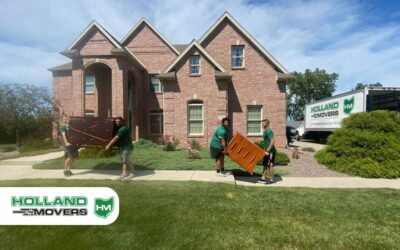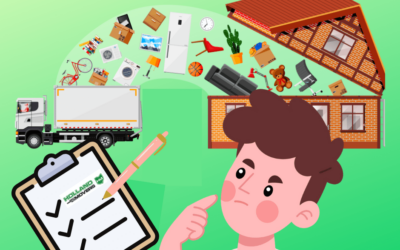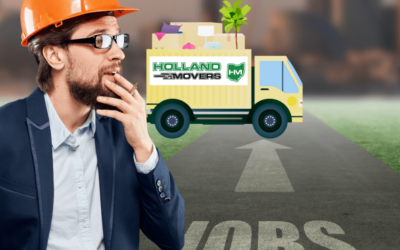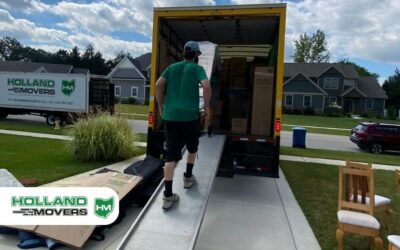Organizing Your Belongings
As you prepare for your move, the initial step is to streamline your possessions. Partnering with professionals like Holland Movers, who specialize in Local Moving, can make this transition smoother. This proactive approach ensures that only necessary and cherished items make the journey to your new abode. Start by classifying your belongings into categories. This method not only simplifies tracking your items but also aids in deciding what to pack together. Next, you’ll face the challenging task of determining what to retain and what to let go. While this might be difficult, it’s a vital step in minimizing clutter and enhancing the efficiency of your move.
In the following sections, we’ll delve into practical strategies for categorizing items and making decisions about what to keep or discard. These tips will simplify the process of organizing your belongings for your upcoming move.
Sorting Items by Category
Initiating the moving process by categorizing your items can make a seemingly daunting task manageable and can pave the way for a systematic packing and moving plan.
Start by establishing clear categories for your possessions. Typical categories could include ‘Clothes’, ‘Books’, ‘Kitchenware’, ‘Electronics’, ‘Toys’, and ‘Miscellaneous’. For a more detailed organization, consider subdividing these categories. For instance, ‘Clothes’ could be further divided into ‘Seasonal wear’, ‘Workwear’, ‘Casual attire’, and so on.
Begin the sorting process by gathering items from the same category from all over your home and grouping them together. This might seem like you’re creating more chaos initially, but it’s a crucial step for effective organization.
Once you’ve grouped all items in a category, it becomes easier to assess what’s necessary and what’s not. This process also aids in estimating the quantity and types of packing supplies you’ll need, a subject we’ll explore in detail in the following sections.
Remember, just like Rome wasn’t built in a day, you don’t have to sort all your items in one go. Allocate sufficient time for this task and handle one category at a time. The secret to success lies in patience and thoroughness.
Deciding What to Keep and What to Discard
After categorizing your belongings, it’s time to make some tough decisions: what stays and what goes? This step, while potentially challenging, streamlines the packing process and can even save you money and space during your move.
Begin by evaluating each item. A good rule of thumb is to consider whether you’ve used the item in the past year. This principle can be applied to a wide range of items, from clothing and kitchen gadgets to books and home decor. If it hasn’t been used and doesn’t hold significant sentimental or monetary value, it may be time to part ways.
Next, think about the item’s role in your new home. Does it fit the space, both physically and aesthetically? If not, it might be time to let it go.
For items that are in good condition but not making the move, consider selling or donating them. This could even offset some moving costs. Items that are damaged or unusable should be disposed of responsibly, with recycling as a preferred option. Remember to safely and correctly dispose of hazardous materials like chemicals and paint.
This process not only helps declutter your current space but also shapes your new home, ensuring it’s efficient and free from unnecessary items.
Securing Packing Supplies
Once you’ve determined what items are making the move, it’s time to gather your packing supplies. This step is crucial to ensure your belongings are safely transported to your new home. The type and quantity of packing supplies needed will largely depend on the items you’re moving, underscoring the importance of the sorting process.
In the sections that follow, we’ll delve into the specifics of identifying the packing supplies you’ll need and how to source and estimate these materials effectively.
Identifying Packing Supplies
The success of your moving day hinges on the quality and appropriateness of your packing supplies. The right materials will not only keep your belongings safe and secure but will also streamline the loading and unloading process. Here’s a rundown of the essential packing supplies you’ll likely need:
Cardboard Boxes: These come in various sizes and are indispensable for storing most of your items. Consider specialized boxes like wardrobe or dish pack boxes for specific items.
Packing Tape: A robust packing tape will ensure your boxes remain sealed and the contents stay put during transit.
Protective Wrapping: Bubble wrap, packing paper, and foam peanuts can provide an additional layer of protection for delicate items.
Labels or Markers: These are essential for marking your boxes, making both packing and unpacking more efficient.
Stretch Wrap: This is ideal for safeguarding furniture or large items against potential damage or dust.
Specialty Packing Supplies: Depending on your needs, you might require mattress bags, sofa covers, or mirror/picture boxes.
Padding Supplies: Repurpose old blankets, towels, or clothing to cushion fragile or valuable items.
The exact mix of packing materials you’ll need will depend on your specific requirements and the items you’re moving. Consult with your moving service provider for tailored advice on packing supplies.
Sourcing and Estimating Packing Supplies
Once you’ve identified the packing supplies you need, the next step is to source them and estimate the correct quantities. Here are some strategies to help you do this effectively:
Look Around Your Home: Before buying new supplies, check what you already have at home. Old boxes, newspapers, and linens can serve as padding and wrapping materials.
Buy New: If you’re short on supplies, consider purchasing from local moving companies, home improvement stores, or online. Be sure to compare prices and quality before making a purchase.
Reuse: Ask local businesses if they have spare boxes to give away. This approach is not only eco-friendly but can also save you money.
Estimating the right quantity of packing supplies is just as important as sourcing them. Here’s how to do it:
Take Inventory: Make a list of all the items you’ll be moving. This will give you a rough estimate of the number and sizes of boxes you’ll need.
Use a Packing Guide: Online packing calculators can help you estimate the quantity and type of packing materials required based on the size of your home or the number of occupants.
Seek Professional Advice: If you’re unsure, consult a moving services professional. They can provide a more accurate estimate based on their experience.
By adequately sourcing and estimating your packing supplies, you’ll be well-prepared for a smooth moving day, ensuring the safety of your belongings and facilitating an efficient unloading process at your new home.
Outline of the Moving Plan
With your possessions neatly organized and your packing materials at the ready, it’s time to shift focus to the next pivotal phase of your pre-moving day preparations: devising a comprehensive moving plan. This plan is your roadmap to a smooth, stress-free relocation, detailing every step from the weeks leading up to the big day to the move itself. It should also include the orchestration of utilities and the synchronization of moving services to fit your timeline. The following sections will delve deeper into the process of crafting a moving timeline and efficiently managing utilities and moving services.
Creating a Moving Timeline
A well-structured moving timeline is your best ally in maintaining organization throughout the relocation process. Here are some steps to consider when constructing your timeline:
- 8 Weeks before Moving: Kickstart your moving plans. Decide if you’ll be enlisting the help of professional movers or going the DIY route. Start the process of sorting your belongings to determine what will make the move with you.
- 6 Weeks before Moving: Begin gathering packing supplies, look into moving insurance, and if your move is long-distance, start planning your travel logistics.
- 4 Weeks before Moving: Start packing items that aren’t daily necessities. Inform all relevant entities of your impending change of address, such as banks, insurance companies, and subscription services.
- 2 Weeks before Moving: Pack the majority of your items, leaving only the essentials unpacked. This is also the time to arrange for the transfer of utilities and confirm your moving plans with your chosen professional movers, if applicable.
- 1 Week before Moving: Wrap up all packing, label boxes clearly, dispose of any items you’ve decided not to take with you, and double-check your moving plan to prevent any last-minute complications.
- Moving Day: If you’ve adhered to your timeline, moving day should primarily consist of loading, transporting, and unloading your possessions at your new residence.
Bear in mind, your moving timeline may require adjustments to cater to your unique moving circumstances. The most important thing is to start planning as early as possible to mitigate any last-minute stress.
Utility Management and Moving Services
The orchestration of utility services and the synchronization with your chosen moving company are vital components of your relocation strategy. Here’s a guide to navigate these tasks:
Managing Utilities:
- Take Stock: Begin by cataloging your current utilities such as electricity, internet, water, gas, and cable TV.
- Notification: Reach out to each utility provider to inform them of your impending move. This advance notice is typically required by most providers.
- Transfer or Terminate: Depending on your new location, you’ll need to decide whether to shift your utilities or end them.
- Establishing New Services: If your existing utilities can’t be transferred, initiate the process of setting up new services promptly.
Coordinating with Moving Services:
- Reserve: Once you’ve selected a moving company, secure their services for your preferred moving date as soon as possible.
- Stay Connected: Keep the lines of communication open with your movers, promptly sharing any changes in your plans.
- Prep Your Home: Ensure your home is ready for the movers by clearing pathways and eliminating any potential obstacles for efficient loading.
- Oversee: On moving day, be present to oversee the loading process, answer any queries, or provide guidance to the movers as required.
By managing your utilities and coordinating with your movers in a timely and orderly manner, you can avoid last-minute chaos and facilitate a smooth move.
Final Preparations for Moving Day
As the day of your move approaches, the importance of final preparations escalates to ensure a smooth transition. This includes assembling an essentials box and preparing both your existing and new homes for the moving process. Additionally, this stage involves tackling any last-minute hiccups that may surface. Collectively, these measures can alleviate the stress often associated with moving, while safeguarding the condition of your possessions. The following sections will delve deeper into each of these final steps.
Packing an Essentials Box
The ‘Essentials Box’ is a crucial component of your moving process, serving as a survival kit during the transition period. It houses the items you’ll need immediately after relocating, before you’ve had a chance to unpack. Here’s how to assemble your essentials box effectively:
Box Selection: Opt for a robust box or suitcase that distinguishes itself from the rest of your moving boxes. It should be spacious enough to hold your indispensable items.
Personal Necessities: Pack personal necessities such as toiletries, medications, clothing, and bedding to last for a few days.
Critical Documents: Safeguard important paperwork like passports, IDs, property documents, and financial records in the essentials box for easy retrieval and protection.
Handy Tools: Incorporate a basic toolkit for immediate tasks in your new abode. This should include items like screwdrivers, a utility knife, pliers, and a measuring tape.
Kitchen Basics: Consider adding non-perishable food items, bottled water, disposable cutlery, a pot, a pan, and a portable stove.
Cleaning Essentials: Include basic cleaning supplies to spruce up your new home before settling in.
Items for Babies or Pets: If you have infants or pets, remember their necessities – food, diapers, toys, leashes, and so on.
The essentials box should be the last thing you pack and the first thing you unpack. The goal is to ensure your initial days in your new home are as stress-free as possible, despite the moving chaos.
Preparing Residences and Dealing with Last-Minute Issues
Even with boxes neatly packed and ready for transport, there are still a few tasks to complete in readying both your old and new homes, as well as addressing any unexpected hiccups.
Current Residence Preparation: Clean your current home thoroughly and conduct a final inspection to ensure nothing is overlooked. Dispose of any waste and clear pathways for easy box removal.
New Residence Preparation: If feasible, visit your new property prior to moving day to conduct basic cleaning, check utilities, and strategize the placement of larger items.
Moving Services Adjustments: Any alterations to your moving timeline or other changes should be communicated to your moving services provider without delay.
Last-Minute Packing: Some items may still need packing on moving day. Approach these with patience and caution to prevent damage.
Addressing Moving Day Challenges: Despite careful planning, unexpected issues may arise on moving day, such as inclement weather, traffic delays, or unforeseen breakdowns. Maintain a calm and flexible attitude, keeping in mind that most problems have solutions.
By meticulously preparing your homes and effectively handling last-minute issues, you can facilitate a smoother moving day and expedite the settling-in process at your new residence.











